Business Insider•June 27, 2020
Welcome to Wall Street Insider, where we take you behind the scenes of the finance team's biggest scoops and deep dives from the past week.
Accenture is cutting US staff, and top execs just warned of more pain to come as the consulting giant promotes fewer people and looks to control costs, Meghan Morris and Dakin Campbell first reported. Their story got a lot of attention this week, and for good reason. It could be an indicator for how the firm's own clients are weathering a downturn, and consulting likely won't be the only industry to feel the crunch.
We also took a look at who's most at risk once Wall Street kicks off the tidal wave of layoffs many banks had put on pause — and why boutique firms without a strong restructuring practice could be "dead in the water," as one recruiter put it.
Dakin along with Casey Sullivan got an inside look at Egon Durban, who became co-CEO of Silver Lake Partners in December. They spoke with more than 40 people who have worked with Durban, or across from him on deals, to understand his rise at the tech-focused private-equity firm he joined as a young banker in 1999.
Read the full story here:
40 insiders reveal the meteoric rise of Silver Lake's Egon Durban, the tech-focused PE firm's No. 1 dealmaker who strong-armed his way to the top and is about to get $18 billion more to invest
Keep reading for a look at why one of the earliest forms of alt-data is breaking down; a rundown of Amazon's rapid-fire moves to scoop up warehouses; and a deep dive into the culture at BTIG.
Inside BTIG

btig wall street sexual discrimination eeoc investigation 2x1
Samantha Lee/Business Insider
The financial-services industry has tried to clean up its image in recent years, but shades of an earlier era on Wall Street have lingered at the firm BTIG, a Business Insider investigation by Nicole Einbinder and Rebecca Ungarino has found.
Read the full story here:
Former employees say BTIG had a toxic party culture that was stuck in the '80s
Samantha Lee/Business Insider
The financial-services industry has tried to clean up its image in recent years, but shades of an earlier era on Wall Street have lingered at the firm BTIG, a Business Insider investigation by Nicole Einbinder and Rebecca Ungarino has found.
Read the full story here:
Former employees say BTIG had a toxic party culture that was stuck in the '80s









